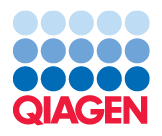Identify QIAseq Hybrid Capture DNA Germline Variants (Illumina)
The Identify QIAseq Hybrid Capture DNA Germline Variants (Illumina) template workflow is designed to call germline variants from data generated with e.g. QIAseq Multimodal DNA Library kit without UMIs or QIAseq FX DNA Library kit followed by hybrid capture-based target enrichment without addition of mitochondrial spike-in probes, such as QIAseq Exome, QIAseq xHYB Human, or panels from a third party provider. For panels from a third party provider, the same approach as described in QIAseq custom panels is recommended.
If mitochondrial spike-in probes have been added, the Identify QIAseq Hybrid Capture DNA Germline Variants including Mitochondrial (Illumina) should be used (see Identify QIAseq Hybrid Capture DNA Germline Variants including Mitochondrial (Illumina)).
The first steps of the workflow involve trimming off any remaining PCR adapters. This is followed by mapping the trimmed reads to the human reference sequence. The Structural Variant Caller then generates a guidance track that is used in the Local Realignment tool to improve the mapping. The improved mapping is then input to the Fixed Ploidy Variant Detection tool. The resulting variants are filtered to remove those located outside defined target regions. Remaining variants are then annotated with information such as the relation to repeat/homopolymer regions or gene elements. Finally, a series of filtering steps removes variants likely to be artifacts. The retained variants are output, along with reports and other associated results.
The workflow can be found at:
Template Workflows | Biomedical Workflows (![]() ) | QIAseq Sample Analysis (
) | QIAseq Sample Analysis (![]() ) | QIAseq DNA workflows (
) | QIAseq DNA workflows (![]() ) | Identify QIAseq Hybrid Capture DNA Germline Variants (Illumina) (
) | Identify QIAseq Hybrid Capture DNA Germline Variants (Illumina) (![]() )
)
Options in the following dialogs can be configured:
- Choose where to run. If you are connected to a CLC Server via the CLC Workbench, you will be asked where you would like to run the analysis. We recommend that you run the analysis on a CLC Server when possible.
- Select Reads. Select the sequencing reads. When analyzing more than one sample at a time, check the Batch checkbox in the lower left corner of the dialog.
- Specify reference data handling. Select the relevant Reference Data Set, see Reference data management for details. QIAseq DNA Hybrid Capture and WGS hg38 will be pre-selected and is recommended for running this workflow.
- Configure batching. If running the workflow in Batch mode, you will be asked to define the batch units. See https://resources.qiagenbioinformatics.com/manuals/clcgenomicsworkbench/current/index.php?manual=Running_workflows_in_batch_mode.html for details.
- Target regions. Choose the relevant target regions from the drop down list.
- Map Reads to Reference. Here, it is possible to configure masking. A custom masking track can be used, but by default, the masking track is set to GenomeReferenceConsortium_masking_hg38_no_alt_analysis_set, containing the regions defined by the Genome Reference Consortium, which serve primarily to remove false duplications, including one affecting the gene U2AF1.
- Fixed Ploidy Variant Detection. Configure the variant detection options.
- QC for Target Sequencing. Set the Minimum coverage parameter of the QC for Target Sequencing tool. Using default settings, samples where 90 percent of target region positions do not meet this threshold will be flagged in the sample report generated by the workflow.
- Copy Number Variant Detection (Targeted). Specify Controls against which the coverage pattern in your sample will be compared in order to call CNVs. If you do not specify a control mapping the CNV analysis will not be carried out. Please note that if you want the CNV analysis to be done, it is important that the control mapping supplied is a meaningful control for the sample being analyzed. Mapping of control samples for the CNV analysis can be done using the workflows described in Create QIAseq Hybrid Capture CNV Control Mapping (Illumina). A meaningful control must satisfy two conditions: (1) It must have a copy number status that is meaningful to compare against. For panels with targets on the X and Y chromosomes, the control and sample should be matched for gender. (2) The control read mapping must result from the same type of processing that will be applied to the sample. For more information about CNV detection see https://resources.qiagenbioinformatics.com/manuals/clcgenomicsworkbench/current/index.php?manual=Copy_Number_Variant_Detection.html.
- Create Sample Report. Specify QC items for assessment and subsequent flagging in the sample report generated by the workflow. For additional information, see https://resources.qiagenbioinformatics.com/manuals/clcgenomicsworkbench/current/index.php?manual=Create_Sample_Report.html.
- Variant filtering steps. A series of dialogs outlines the filtering cascade in this workflow. Note that the dialog names can start with Identify candidate variants, Remove or Define. The filtering cascade has been tuned using samples of relatively high quality and coverage to provide the best possible sensitivity and precision. Additional filtering may be needed, or filtering values may need to be adjusted, when working with low quality/coverage samples or when seeking a different balance between sensitivity and precision. See https://resources.qiagenbioinformatics.com/manuals/clcgenomicsworkbench/current/index.php?manual=Filter_on_Custom_Criteria.html for details on how to adjust the options.
- Result handling. Choose if a workflow result metadata and/or log should be saved.
- Save location for new elements. Choose where to save the data, and press Finish to start the analysis.
If you are connected to a CLC Server via the CLC Workbench, you will be asked where you would like to run the analysis. We recommend that you run the analysis on a CLC Server when possible.
Launching using the QIAseq Panel Analysis Assistant
The workflow is also available in the QIAseq Panel Analysis Assistant under Human Exome and xHYB Human.
Subsections
- Output from the Identify QIAseq Hybrid Capture DNA Germline Variants (Illumina) workflow
- Identify QIAseq Hybrid Capture DNA Germline Variants including Mitochondrial (Illumina)
